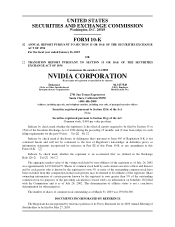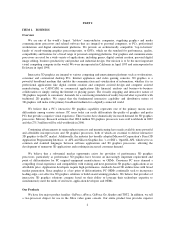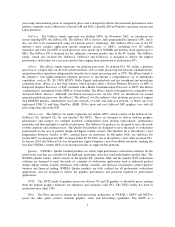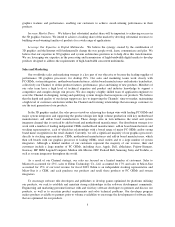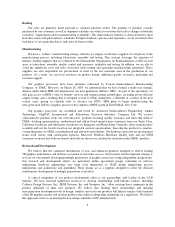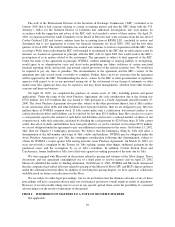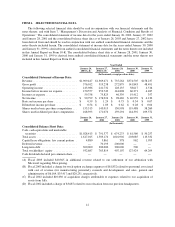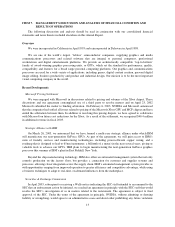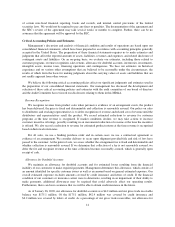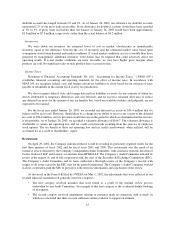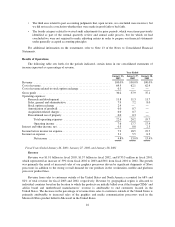NVIDIA 2003 Annual Report Download - page 9
Download and view the complete annual report
Please find page 9 of the 2003 NVIDIA annual report below. You can navigate through the pages in the report by either clicking on the pages listed below, or by using the keyword search tool below to find specific information within the annual report.We have substantially increased our engineering and technical resources and have 832 full-time employees
engaged in research and development as of January 26, 2003, compared to 619 employees as of January
27, 2002. During fiscal years 2003, 2002 and 2001, we incurred research and development expenditures of
$224.9 million, $154.8 million and $86.0 million, respectively.
Competition
The market for 3D graphics processors for PCs is intensely competitive and is characterized by rapid
technological change, evolving industry standards and declining average selling prices. We believe that the
principal competitive factors in this market are performance, breadth of product offerings, access to customers
and distribution channels, backward-forward software support, conformity to industry standard APIs,
manufacturing capabilities, price of graphics processors and total system costs of add-in boards or motherboards.
We expect competition to increase both from existing competitors and new market entrants with products that
may be less costly than our 3D graphics processors or that may provide better performance or additional features
not provided by our products.
Our primary source of competition is from companies that provide or intend to provide 3D graphics
solutions for the PC market. Our competitors include the following:
• suppliers of integrated core logic chipsets that incorporate 3D graphics functionality as part of their
existing solutions, such as Intel, Silicon Integrated Systems, ATI Technologies Inc. and VIA
Technologies, Inc.;
• suppliers of graphics add-in boards that utilize their internally developed graphics chips, such as
ATI Technologies Inc., Creative Technology and Matrox Electronics Systems Ltd.;
• suppliers of mobile graphics processors that incorporate 3D graphics functionality as part of their
existing solutions, such as ATI Technologies Inc., Trident Microsystems, Inc. and the joint venture of a
division of SONICblue Incorporated (formerly S3 Incorporated) and VIA Technologies, Inc.; and
• companies that have traditionally focused on the professional market and provide high end 3D solutions
for PCs and workstations, including 3Dlabs (a Creative Technology company) and ATI Technologies
Inc.
If and to the extent we offer products outside of the 3D graphics processor market, we may face competition
from some of our existing competitors, as well as from companies with which we currently do not compete. We
cannot accurately predict if we will compete successfully in any new markets we may enter.
Patents and Proprietary Rights
We rely primarily on a combination of patents, trademarks, trade secrets, employee and third-party
nondisclosure agreements and licensing arrangements to protect our intellectual property. As of January 26,
2003, we owned 91 issued United States patents, 16 issued foreign patents, and have 203 United States patent
applications pending and 19 foreign patent applications pending. Our issued patents have expiration dates from
September 4, 2007 to October 16, 2020. As of January 26, 2003, our patents and pending patent applications
related to technology used by us in connection with our products, including our graphics processors. Our pending
patent applications and any future applications may not be approved. In addition, any issued patents may not
provide us with competitive advantages or may be challenged by third parties. The enforcement of patents by
others may harm our ability to conduct our business. Others may independently develop substantially equivalent
intellectual property or otherwise gain access to our trade secrets or intellectual property. Our failure to
effectively protect our intellectual property could harm our business. We have licensed technology from third
parties for incorporation in our graphics processors, and expect to continue to enter into license agreements for
future products. These licenses may result in royalty payments to third parties, the cross licensing of technology
by us or payment of other consideration. If these arrangements are not concluded on commercially reasonable
terms, our business could suffer.
7

